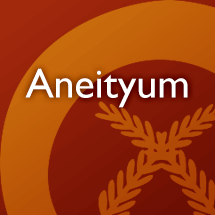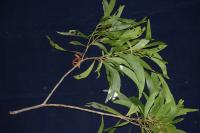Your search for * in agriculture has returned 100 entries
ahtowan
v. to weed
bookmarkahwai lelcai
v. to plant weeds; to make a wilderness or a waste
bookmarkaihon
v. to spit on leaves; to chew leaves for sickness
bookmarkauhorohos
v. to weed; to clear land
bookmarkauoc
adj. unripe
bookmarkecetaig jai
v. to come out, as banana fruit
bookmarkehlili
v. to burn ground for planting
bookmarkelgai
v.n. expand as a leaf
bookmarketgei
v. to weed
bookmarketti
v. to split leaves
bookmarkeucte
v. to begin to blossom
bookmarkheto
v. to grow again, as hair, feathers, plants; to come out, as teeth
bookmarkhui asan
v. trees; fruit
bookmarkilihilo
adj. soft, as an infant’s foot, or new leaves.
bookmarkimjav
adj. soft, over-ripe, as breadfruit.
bookmarkinceimu
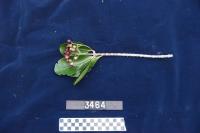
n. tree, 7 m tall (collection: Gregory M. Plunkett #3464)
Example: This is a sacred plant. The wood is used for rafters in house building. To plant taro, take an 8 cm diameter stick, sharpen it and use to make holes for planting. The stick is as long as needed for a person to stand while making the hole.
bookmarkincipinti
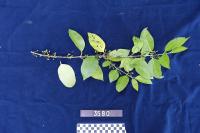
incipiñti
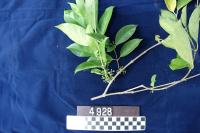
incipiñti

incoujahao
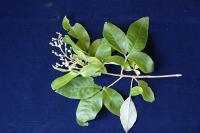
n. shrub, 2 m tall (collection: Gregory M. Plunkett #3548)
Example: The forked stick of this plant is used as a pole to hold the outrigger on a canoe. Children blow the small fruits of this plant through the hollow petioles of the papaya leaf or a hollowed bamboo stem as a game. As an aphrodisiac, two handfuls of the leaves of this species are boiled in fresh water and men drink these for 7 days. The next week they will be "strong." People cannot have sex while they are drinking this remedy, but then the next week when they have finished the treatment, they will be "very strong."
bookmarkinlapnan
n. a plantation
bookmarkinlop̃otjap
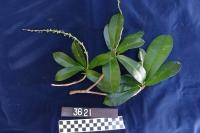
inmal acujitai
n. a collection of plantations
bookmarkinmal ahapol
n. a group of cultivations
bookmarkinmejei

inpa u natmas
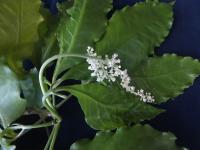
n. tree. Growing near village. (collection: Ashley A McGuigan #13)
Example: 1. To cure toothache when pregnant - Take the inner bark from Intejed and boil it in a pot of seawater (about 1 liter) along with 2 leaves from each of inpoutnatmas, narayag, nahayag, and nelmaha. Boil until juice is visibly leaving the plants. Put this water into your mouth and hold it there for 2-3 minutes. Do this this with one cup in the morning, 1 cup in the afternoon, and 1 cup in the evening. 2. This plant is special and people grew it – use it after burial of a chief – wash hands with these leaves and water to cleanse the people who buried the chief. 3. Name means belongs to the spirit
bookmarkinteses

n. parasite in tree, flowers orange with reddish base. Growing in secondary forest. (collection: Michael J. Balick #5000)
Example: This plant is said to have a type of magical use. Young men take one node of the stem of this plant and use it in an unspecified way to attract young women.
bookmarkinteses
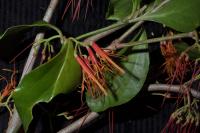
n. parasite on branches of Geissois denhamii tree, growing in dense rainforest. Flowers orange-red. (collection: Gregory M. Plunkett #4028)
Example: 1. This plant is known to kill other trees and is regarded as a parasite. 2. The plant is related to kastom use regarding the separation of two lovers--more information witheld.
bookmarkinteucjip
n. bush land where forest trees grow; also "intucjip"
bookmarkintinan
n. a bed, a foundation, a plantation
bookmarkinyje
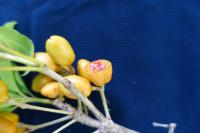
n. tree to 15 m, dbh 20 cm (collection: Michael J. Balick #4914)
Example: Use the leaves to make compost to be placed at the bottom of the hole where taro is to be planted, cover with soil and grow the taro in that hole. Serves as a fertilizer.
bookmarkisji ariko
v. to gather beans
bookmarkisjid
v. to chip off small branches
bookmarkkidie ~ kithi
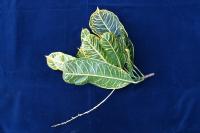
n. shrub, 1. 5 m tall (collection: Gregory M. Plunkett #3205)
Example: 1. Plant this tree at each of the four corners of a fence to keep your pigs in and protect against a type of bad luck. If a man sleeps with his wife who is having her period, and then the man goes to see the pig, the pig will suffer and not grow strong and not have many piglets. So the presence of this plant controls against bad luck that others can bring to your pig farm. 2. This is an ornamental plant grown around the home. Sticks of this plant are planted around the outside of the garden and grow to create a fence, to protect the crops and keep them healthy, as well as protect the crops from people that are not cleansed in the ritual way. 3. This species is also planted around the house to add color and is very decorative in general. 4. For fertilizer in taro holes for water taro. For baly(?) taro and water taro, lay these flat on the surface of the charcoal, then lay the food – taro, cassava – on this and cover with another layer, add hot stones and cook. 4. Pig food, goat food.
bookmarklelen
adj. unripe
bookmarkmasoa

n. herb to 1 m, fruits green (collection: Michael J. Balick #4915)
Example: This plant was said to have been brought in by the early missionaries, used to starch their clothes and grown as a crop for export to England. Used as a food crop as well, the root is mashed, dried in the sun and kept until needed. To process, put the roots in a bowl, add water and soak for 1 day and night, pour off the water and keep the starch. Prepare this food like lap-lap that is cooked on a fire in a pan.
bookmarkmeto
adj. ripe; also "metto"
bookmarkna elmai
n. cloth (related to nelmai)
bookmarknametreyeñ
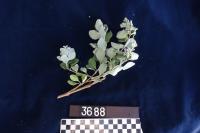
namji
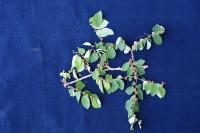
n. tree, 4 m tall (collection: Gregory M. Plunkett #3508)
Example: 1. The stems of this plant are sharpened and used to plant swamp taro or dry land taro. 2. Break small branch top put behind ear if you go to an unknown place and keep behind ear and sleep with it. If the place is safe you will sleep if it is not you will not sleep well – only behind ear when you sleep.
bookmarknamrop̃om
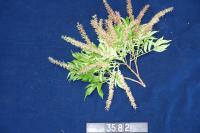
n. tree, 7-8 m tall (collection: Gregory M. Plunkett #3582)
Example: Firewood, timber good for bush houses. Calendar plant – when it is in flower, the old people know it is time to harvest root crops, like yam and other vine crops, in the wild, as yet unspecified. Local names = INYAC, NOMODEJ TAL, NOMODEJ WOU, NOU LELCEI… etc.
bookmarknanad
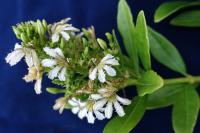
nanad

n. shrub. Growing near the beach. (collection: Ashley A McGuigan #4)
Example: 1. Dried branches from this plant can be used to roast vegetable crops that women eat if they have problems becoming pregnant. 2. Firewood, burns well. 3. Some people will eat the green fruit for protection against black magic. Eat 5 fruits for this. Eat it only once – will last for a year.
bookmarknanad cop̃ou

n. small shrub, 0. 5 m tall (collection: Gregory M. Plunkett #3219)
Example: 1. A stimulant plant. If a person is going to their garden early in the morning before the sun come up, break 2 top young leaves and chew and swallow the liquid, spitting out the fiber. This makes the person able to work harder and not feel tired while in the fields. It was noted that "a person can do the work of many people if they chew this." 2. The leaves are used for fertilizer for taro--put a bunch of leaves in a hole were taro is to be planted as a compost/antibiotic. This practice is said to kill all of the bad organisms such as bacttively impact the health of the taro plant. 3. This species is collected in the coastal areas, and is different from the one that looks similar to it, that grows in the forested areas. People take 4 leaves, chew leaves, swallow juice, gives energy to work hard the entire day. For fishing, take lots of ripe fruits and put in pocket, you will be able to catch a lot of fish. It brings good fortune when fishing. Roots – take one root, wash where a woman is giving birth to a newborn baby, give a drop of the juice from the root to clear the mucus in the throat.
bookmarknanad itohou
![1. The leaves of this plant are used as a fertilizer when a person plants taro "to help to feed the ground for next year." 2. Sapwood of this tree, and one more [GMP 3591], in old days take from west side and cross mountain to the east, and on red clay mountain, burn it to make spirits to give more sun instead of rain so that gardens will grow well.](/media/aneityum/pix/GMP_3456_MJB_43-scaled.jpg)
n. shrub, 2 m tall (collection: Gregory M. Plunkett #3456)
Example: 1. The leaves of this plant are used as a fertilizer when a person plants taro "to help to feed the ground for next year." 2. Sapwood of this tree, and one more [GMP 3591], in old days take from west side and cross mountain to the east, and on red clay mountain, burn it to make spirits to give more sun instead of rain so that gardens will grow well.
bookmarknapun nitai caig
n. the skin or rind of food
bookmarknarahcai
n. a table made of reeds, for drying arrowroot, etc.
bookmarknaravi
n. a gathering of inmops or horse-chestnuts
bookmarknared

n. vine to 3 m, sori brown. (collection: Michael J. Balick #4930)
Example: Take a handful of the vine, twist it into rope with many stems of the vine, and use it to tie bundles of sugar cane. It can also be used to tie wild canes (Miscanthus) to the roof of the house. Take a handful of the vine, twist it into rope with many stems of the vine, and use it to tie bundles of sugar cane. It can also be used to tie wild canes (Miscanthus) to the roof of the house.
bookmarknariko cei
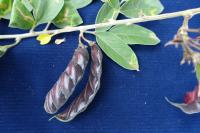
n. fence-forming shrub, 1. 5 m tall (collection: Gregory M. Plunkett #3206)
Example: 1a. Cultivated in gardens. Cook seeds of this species or eat them raw before they are fully ripened. The green pods can also be cooked in a fire and eaten. 1b. Cultivated plant for its edible seeds, can be prepared in a pot of bamboo. OR could take branches w/ seeds and put directly on the earth oven for cooking. 2. Planting this species adds nitrogen to the soil--grow it on soil that is said to be "tired."
bookmarknasanma
n. the juice of the breadfruit tree
bookmarknasau
n. a crop; fruit which grows spontaneously
bookmarknauhap̃ apeñ
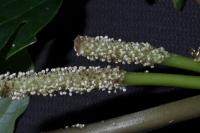
naupiñiña
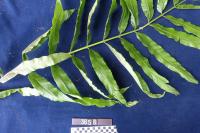
n. terrestrial fern, growing in secondary forest along the river. Leaves c. 2. 25 m long. (collection: Gregory M. Plunkett #3656)
Example: Put several leaves of this species together to wrap food, especially the fresh water eel, and to carry plants of taro, kava, holding the leaves over one’s shoulder to carry these crops.
bookmarknecsap
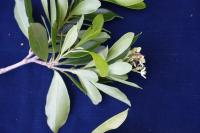
n. shrub to 2 m, flowers white. Red clay soil (collection: Michael J. Balick #4887)
Example: The stem makes a good digging stick to plant taro. Also branches of this tree are cut to tie the canoe to the outrigger. Used for the small sticks that sit at the base of the larger sticks that hold the outrigger (see photos).
bookmarknecsap̃
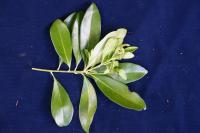
n. shrub, 2 m tall (collection: Gregory M. Plunkett #3534)
Example: This tree has very hard wood. 1. Use the small stems to plant dry land or swamp taro, sharpening the end and pushing it into the ground to make a hole. 2. It also is useful for fence, posts for houses. 3. Small stems are also used to make a comb for the hair. 4. Plant pole for taro kava. 5. A branch is shaped and used to husk coconut. 6. The wood is hard and in ancient times people would take a forked piece and put string on one side of it, sharpen the other side and use with the string as a fish hook – need to keep rope tight until it is in the canoe. Do not give it slack – strong use AAM 17.
bookmarknehgan
n. a stock; a bunch, as of fruit; also "negan" or "nigan"
bookmarkneihon
n. a chewing of wood, and spitting it on sick people, to cure them; also "naihon"
bookmarkneijis ieg
n. a bundle of reeds for a torch; a torch
bookmarknerid u uncat
n. the tow of flax
bookmarknesei
n. forest
bookmarknetcetas

netcetec
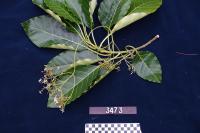
n. trees, 3-4 m tall (collection: Gregory M. Plunkett #3473)
Example: 1. This species is excellent for firewood as it gives off less smoke than other types of wood. 2. The wood is good for making roof rafters on which to tie thatch. 3. Use this for planting pole, for taro, cane, and kava.
bookmarkneyo
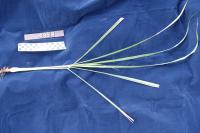
n. grass to 70 cm tall, sterile. Cultivated at the side of a field. (collection: Michael J. Balick #4958)
Example: The leaves and stems are boiled in water to make tea. The base of the leaves (the whitish part) is used to cook foods that have a strong odor, such as goat or shark. The base is sliced and put in the soup and this helps to keep the smell of the goat or shark from infusing through the rest of the food and making it less palatable. In some areas of Aneityum, such as in cassava fields, there is a fungus that kills the crops. This species is interplanted with the crops to kill that fungus and protect the crop plants.
bookmarkniditau

niditau

n. tree to 8 m, dbh 20 cm (collection: Michael J. Balick #4867)
Example: Fruits are sweet and edible when ripe. This plant is an indicator of rich soil, a good place to plant one’s garden. The leaves of this species are mixed in with other leaves for an unspecified local medicine that helps to remove spiritual sickness
bookmarkniditau
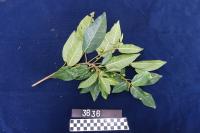
n. tree, 8 m tall (collection: Gregory M. Plunkett #3636)
Example: The green fruits are edible, as are the young leaf apices--cook these in water and eat them. The wood is used for temporary houses, for example, to provide shade in a garden. For planting taro, or any root crop, sharpen the end of a stick of this tree and use it for making holes, particuarly in river sand where some crops are planted. This tree grows near the river and is an indication that this land is good for agriculture. The wood from the tree is very good for firewood. Name means "who are you." Plant used as an indicator of a tabu place. Take a branch and put it where another person is building or gardening and there is a dispute over that area of land. When this plant is placed there the person who is using the land should stop working it.
bookmarknijhinga
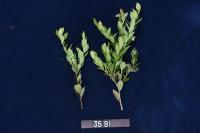
n. shrub, 1-1. 25 m tall (collection: Gregory M. Plunkett #3591)
Example: The fruits of this species are edible when ripe (black) and are very sweet. It grows in the white grass area in the open. It is "numba one" fruit. If a person eats a lot of these it turns their tongue reddish-purple.
bookmarknijinga

n. shrub to 2 m, flowers blue-purple. Red clay soil (collection: Michael J. Balick #4878)
Example: A stem of this shrub is sharpened and used to dig a hole for planting kava. When a person plants kava in a hole made from this stick, there is the belief that it will make kava root stems strong and large. The fruits are edible when ripe and said to be sweet.
bookmarknijmese
n. green foliage
bookmarknodieg
n. a bundle of reeds; also "nohudieg"
bookmarknoducnas
n. a bunch of taro
bookmarknomropom
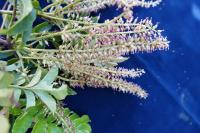
n. shrub to 2 m, flowers white (collection: Michael J. Balick #4874)
Example: This plant is an indicator of rich soil, especially up on the hills from the coast. Therefore, this is where people choose to do their gardens. This specimen is in red soil that is not rich so it does not grow tall, but in the mountains it does grow tall and that is where gardens are planted. Wood from the tree is used for carving.
bookmarknomrop̃om̃

nopou

n. tree to 5 m, dbh 10 cm (collection: Michael J. Balick #4881)
Example: The wood of this tree is used to make house-posts, it is strong. The leaves are used as a compost for the taro patch; line the hole with the leaves of this tree, then place soil over that and plant the taro. When the fruits are ripe, local people say that the hermit crabs are "fat" and ready to collect and eat. When a person is in the forest and there is no coconut fruit fiber to start a fire with, use a dry stick, shave it and use a match to start a pile of this tinder to make a good fire. The wood is said to be "oily." This gives it a nice aroma. To perfume coconut oil, drop the dry flowers in it--use 1 handful of dried flowers added to a pot of oil boiling on the fire while making it. Strain out flowers and the oil smells good. Flowers can also be added to the oil once it is bottled to perfume it.
bookmarknop̃ou
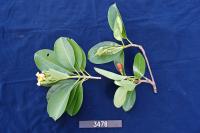
n. large epiphyte on dead tree, growing in open forest. (collection: Gregory M. Plunkett #3478)
Example: The wood of this plant is very hard and can be used for house posts. Because the wood is somewhat heavy, younger stems can be sharpened at one end and the pole can be used to plant dryland taro, to make holes for the tubers. For planting swamp taro, the leaves can be used to line the pit that the taro is planted in; it is a local fertilizer for the taro, and as it rots the soil becomes soft while the taro is growing. The flowers are placed behind one’s ear to enjoy the fragrance or can also be used to make a floral necklace (Intañ).
bookmarknop̃ou

n. tree. Found in the village, usually grows in the hills. (collection: Ashley A McGuigan #16)
Example: 1. Lot of oil in the heartwood so it is good to start a fire, split it into small strips and you can light it for a fire. 2. Calendar plant – when the fruits ripen people know that this is the best season to eat the big hermit crab – meaning that they are fat.
bookmarknoyeiwow
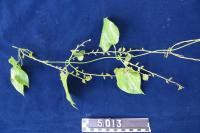
n. vine to 4 m, cultivated (collection: Michael J. Balick #5013)
Example: This is a cultivated, edible tuber. If a cyclone comes and blows the vines, the tuber will still be intact. The vines of this type of Dioscorea are very strong. Normal yam vine tears in high winds and the tuber will not grow for food but will die; this one will not. It is very good for places with strong winds and storms.
bookmarknuka
n. leaves for an oven
bookmarknumta
n. shoots of taro for planting
bookmarknumurumu
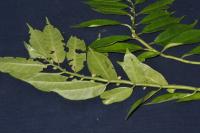
n. epiphyte on Syzygium tree, growing in secondary forest along trail above river. old fruits. (collection: Gregory M. Plunkett #3660)
Example: Put several leaves of this species together to wrap food, especially the fresh water eel, and to carry plants of taro, kava, holding the leaves over one’s shoulder to carry these crops. Used as a baby’s remedy for when the baby is crying too much because the parents are having to much sex. The baby will also be slow to grow and be thin. To remedy this, must wash the baby with the following mixture: nekei atimi (bark), nohos atimi (green skin of the stem), nepnatimi ataman (part not specified). Scrap about 1 inch cubed of the nekei atimi into your hand along with 1in x 4in of the first layer of the green skin of the banana stem (nohos atimi), and the top 8 leaves from about two separate branches of the nepnatimi ataman. Bind all ingredients together and pound them and put everything in the baby’s water for bathing. Wash the baby in water made with this mixture. Do not wipe the baby dry but let it air dry. The next day when you wash the baby with soap, you must re-wash them with the mixture again. Do this for 5 days with the same water mixture. It may small bad but that is okay. Finally on day 5, take the juice from the outter layer of skin on the stem of the banana, nohos atimi, and give a full spoonful of the juice to the baby to drink. Other plants can be added to the bathing water but these are the three primary ingredients.
bookmarkoho
v.n. to bear fruit as a tree
bookmarkohod
n. bundle of leaves, as of nasiaij
bookmarkpak
adj. unripe
bookmarkpakauoc
adj. unripe
bookmarkrere
adj. leafless; fading
bookmarktite
adj. ripe early in the season
bookmarkucsalad tiklai cai
v.a. to lop off small branches
bookmarkugnyiv
adj. rich; good, as applied to fruits
bookmarkuman
n. garden
bookmarkumnad
adj. rotten, applied to fruit
bookmarkupasin
n. first shoots of old roots
bookmarkupuhasin
n. sprouts
bookmarkupumure
v.n. to fall, as unripe fruit
bookmarkwud yi encreucaig
v.a. beat so as to shake a tree
bookmarkyecreig
adj. beginning to be ripe, as fruit
bookmark